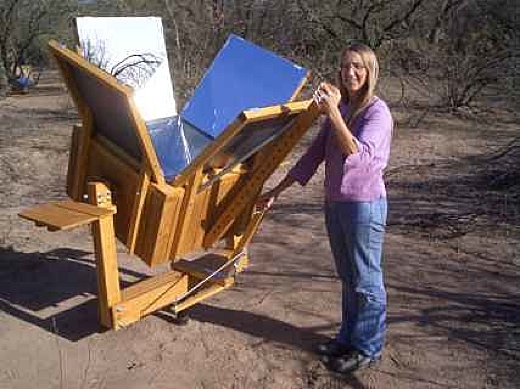By Juan Wilson on 13 May 2011 for Island Breath -
(http://islandbreath.blogspot.com/2011/05/solar-ovens-part-one.html)

Image above: Greenhouse style solar oven prototype built from scratch codenamed "Hibiscus". Photo by Juan Wilson.
Around the beginning of the year I became interested in building a solar cooker. I was inspired by two articles posted by John Michael Greer at the end of 2010 in the ArchDruid Report.
The Haybox Factor
(http://islandbreath.blogspot.com/2010/12/haybox-factor.html)
The Tarpaper Shack Principle
(http://islandbreath.blogspot.com/2011/01/tarpaper-shack-prnciple.html)
The first was a way of slow cooking in an insulated box after heating the cooking vessel on a stove, and the other was about using the direct radiation of the sun to cook food in a box heat trap. My reaction was to build a two-in-one haybox/solar-oven. Specifically, the goal was to build an insulated container that could be heated by solar radiation and hold that heat to provide slow cooking like a crock-pot. I knew going in that this was an experiment and that there would likely be missteps along the way. It would be more sensible to simply buy a commercially manufactured solar oven and try and insulate it or, on the other hand, buy a crock-pot and run it off an inverter off a battery fed by a couple of solar panels. As it turned out those alternatives would have been in the first case cheaper, in the other more effective. None the less the unit I built does to an extent work. It took three major overhauls and several minor modifications to get it to where it is today. along the way I learned a lot - so much that I really need to re-build the unit from scratch. But more on that later.
Crucible or Greenhouse
If you are considering building (or buying) a solar oven there are two major types that are quite different. In one case the sunlight is trapped in an enclosure with a "Greenhouse" effect. Often flat reflective surfaces are used to multiply the effect of the sun. In the other case curved (parabolic) reflective surfaces focus sunlight in a "Crucible". Today when I searched YouTube for "How to build solar oven" I go 545 matches (http://www.youtube.com/results?search_query=how+to+build+solar+oven).
You can build a parabolic reflector "crucible" that will focus sunlight on a small area and cook food like you might fry an ant with a magnifying glass.
These cookers are effective generating high temperature in a small space. It's like cooking over a very small hot charcoal grill. The materials for highly reflective curved surfaces is quite expensive. The temperatures achieved will set lumber on fire in short order. Even a short period of bright sun can grill meat, however, cleanup can be difficult.
Example of Crucible
Video above: Grilled cheese sandwich in a minute over parabolic mirror. From (http://www.youtube.com/watch?v=aJ22QCAqFCc).
You can build a flat reflector "greenhouse" that will capture sunlight ins a cooking space like melting ice-cream in a closed car in the sun. These cookers are effective in holding medium temperature in a large space. It's like cooking in an oven set to 250º. The materials can be as cheap as tinfoil and cardboard. The temperatures achieved make it hard to boil water unless the sun is bright an the unit efficient. It will take hours to cook a casserole or soup. It is best to use glass mirrors to multiply light into the box.
Example of Greenhouse
Video above: Baking potatoes with tinfoil and glass in a box. From (http://www.youtube.com/watch?v=tt1DgZp0n2g).
For a wider spectrum of cooking options you might build a Crucible and a Greenhouse. That is what what one women did with tinfoil and cardboard.
A Bit of Both
Video above: Cooking vegetables in the Greenhouse and meat in the Crucible. From (http://www.youtube.com/watch?v=8JOSGSGM0KA&NR).
The biggest short coming (besides efficiency) is what happens if it rains. Both the Crucible and Greenhouse solar ovens tend to be bulky and large. They will likely spend a lot of time outdoors, and need to be weatherproof to get through a year. I chose to build a Greenhouse oven. With these types of ovens you need to plan several hours in advance when preparing a meal. Those of you who have had crock-pots know the drill. You have to know before you go to work what you want for dinner - and do something about it.

Image above: Demonstration of how to build high performance Greenhouse oven. From (http://www.omick.net/solar_ovens
/current_solar_oven.htm).
The link above is an example of a high performance Greenhouse solar oven that is rugged and high performing (400ºF). I think it's about the best design for a do-it-yourselfer I've found, although it's quite a bit of work to construct. I used some of what these folks learned in making my solar oven.
But, before you try and make your own oven, look at some of the commercial products out there. Commercial Products There are many commercial solar ovens available online. One of sites with the widest selection is www.solarovens.net. They have have many videos of products in action. Here's a video of a commercial parabolic oven that is available for about $700.
Video above: A high performance parabolic "Crucible" oven. From (http://www.youtube.com/watch?v=yzbKXZQeTTA).
Here's a video of a popular reflector box oven that is available for about $200.
Video above: Demonstration of popular "Greenhouse" style Sun Oven product. From
(http://www.youtube.com/watch?v=VKPlrVLtgxM).
In Part Two of this series I will detail building my first "Greenhouse" solar oven and its performance.
Ea O Ka Aina: Solar Ovens - Part Two 5/18/11
Ea O Ka Aina: Solar Ovens - Part Three 5/26/11
.
1 comment :
I have only put a glass pan in the oven at a high temperature once, before I knew that it should not be done. High Temperature Ovens
Post a Comment